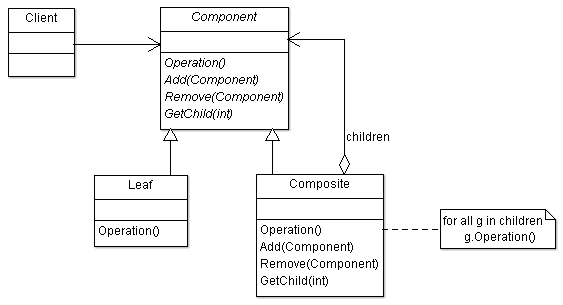> Design Patterns > Composite Design Pattern
Composite Design Pattern
Composite design pattern is used to handle primitive and composite objects uniformly.
Intent
- Compose objects into tree structures to represent part-whole hierarchies. Composite lets clients treat individual objects and compositions of objects uniformly.
The intent of composite design pattern is to compose the object to present part-whole hierarchy and handle both primitive and composite object uniformly.
Problem
- The primitive and composite objects have to be handled differently. To distinguish these objects for manipulation increases the complexity.
Solution
- Come up with a way to manipulate the primitive and composite object uniformly.
That means both the primitive and composite object have to be handled in similar manner.
Where composite design pattern is applicable?
- When part-whole hierarchy of object has to be represented.
- Wherever primitive and composite objects have to be handled in similar manner.
- Directories and Files in File system are the best example.
Composite Design Pattern UML Structure

Participant classes of composite design pattern
- Component class provides the interface Operation().
- Concrete classes Leaf and Composite implements the method Operation().
How they work together?
- Composite has instance of the class Component. It has objects which can be Leaf and Composite as well. It traverses them and does the operation on all the elements it has composed, either primitive or composite.
- The method Add(), Remove() and GetChild() can be provided in Component or Composite, its transparency vs safety. Providing it in Component class makes it transparent and providing it in Composite class makes it safe.
- So you can see both the primitive and composite objects are handled in similar manner.
Composite Design Pattern Example
Here is the composite design pattern example.
There is Monitoring System to monitor applications and resources. These applications uses resources like system, database etc. Same resources and some other resources are available and used for other purpose. Compose application and resources objects into tree structures to represent part-whole hierarchies. Treat individual objects and compositions of objects uniformly.
Implementation Code
| C++ | Composite Pattern in C++ | Composite Pattern C++ Example |
| C# | Composite Pattern in C# | Composite Pattern C# Example |
| Java | Composite Pattern in Java | Composite Pattern Java Example |
| Python | Composite Pattern in Python | Composite Pattern Python Example |
| JavaScript | Composite Pattern in JavaScript | Composite Pattern JavaScript Example |
| PHP | Composite Pattern in PHP | Composite Pattern PHP Example |
| Ruby | Composite Pattern in Ruby | Composite Pattern Ruby Example |
| Swift | Composite Pattern in Swift | Composite Pattern Swift Example |
| Objective-C | Composite Pattern in Objective-C | Composite Pattern Objective-C Example |
Suresh Kumar Srivastava is founder of online learning site coursegalaxy.com and author of popular books C In Depth, Data Structures Through C In Depth. He has 18+ years experience in industry and worked on architecture and design of multiple products. This article Composite Design Pattern is from his Design Patterns course.

